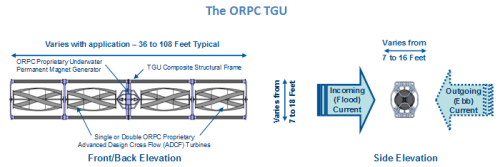
The system’s core component, the proprietary Turbine Generator Unit (TGU) is deployed below ORPC’s research and testing vessel, the Energy Tide 2, and has a maximum design capacity of 60 kW. Test results show that the TGU’s electrical output meetsm, or exceeds, expectations for the full range of current velocities encountered.
The TGU incorporates proprietary cross-flow turbines, a permanent magnet generator, a substantially composite support frame, and a power electronics system that converts the generator’s variable output to grid-compatible power. The turbines were manufactured from composite materials by US WindBlade of Bath, Maine.
The ORPC TGU works on the same principle as a wind turbine, with rotating foils that power the generator. But because water is over 800 times denser than air, the TGUs provide significantly more power than wind turbines at relatively low water current speeds. Built primarily with composite materials, they resist corrosion in both fresh and salt water. As gearless units, they require no lubricants, and emit nothing into the surrounding water.
ORPC will use the data obtained from the Beta Power System to fine tune the design of its commercial TidGen™ Power System, planned for installation in Eastport in late 2011. The TidGen Power System will be connected to the New England grid through the Bangor Hydro Electric Company system and will generate enough electricity to power 50-75 homes.
“Proving the efficacy of the Beta Power System and its ability to generate grid-compatible power day in and day out is a huge milestone for America’s ocean energy industry,” says Chris Sauer, president and CEO of ORPC. “It reaffirms the limitless opportunities to advance the nation’s renewable energy agenda and ensure a more sustainable future.”
Tidal energy has the potential to be a billion dollar industry in Maine within the next 7-10 years, creating hundreds of jobs.
Over the next two months, ORPC will also be demonstrating how tidal energy can be delivered to the US Coast Guard for use at its Eastport station through a battery electrical supply system that is charged aboard the Energy Tide 2. This is the first application of tidal energy by a federal agency.
ORPC holds Federal Energy Regulatory Commission (FERC) preliminary permits and is in the process of obtaining FERC pilot project licenses for tidal energy sites in Maine and Alaska, which have been designated world-class tidal resources by the World Energy Congress.
ORPC’s work is funded in part by Maine Technology Institute and the US Department of Energy.



